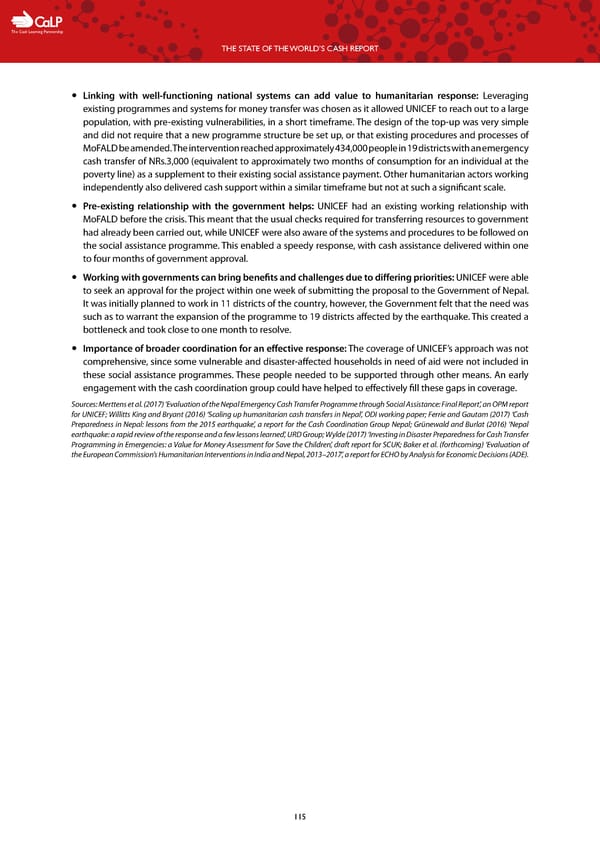C The Cash Learning Partnership THE STATE OF THE WORLD’S CASH REPORT — Linking with well-functioning national systems can add value to humanitarian response: Leveraging existing programmes and systems for money transfer was chosen as it allowed UNICEF to reach out to a large population, with pre-existing vulnerabilities, in a short timeframe. The design of the top-up was very simple and did not require that a new programme structure be set up, or that existing procedures and processes of MoFALD be amended. The intervention reached approximately 434,000 people in 19 districts with an emergency cash transfer of NRs.3,000 (equivalent to approximately two months of consumption for an individual at the poverty line) as a supplement to their existing social assistance payment. Other humanitarian actors working independently also delivered cash support within a similar timeframe but not at such a significant scale. — Pre-existing relationship with the government helps: UNICEF had an existing working relationship with MoFALD before the crisis. This meant that the usual checks required for transferring resources to government had already been carried out, while UNICEF were also aware of the systems and procedures to be followed on the social assistance programme. This enabled a speedy response, with cash assistance delivered within one to four months of government approval. — Working with governments can bring benefits and challenges due to differing priorities: UNICEF were able to seek an approval for the project within one week of submitting the proposal to the Government of Nepal. It was initially planned to work in 11 districts of the country, however, the Government felt that the need was such as to warrant the expansion of the programme to 19 districts affected by the earthquake. This created a bottleneck and took close to one month to resolve. — Importance of broader coordination for an effective response: The coverage of UNICEF’s approach was not comprehensive, since some vulnerable and disaster-affected households in need of aid were not included in these social assistance programmes. These people needed to be supported through other means. An early engagement with the cash coordination group could have helped to effectively fill these gaps in coverage. Sources: Merttens et al. (2017) ‘Evaluation of the Nepal Emergency Cash Transfer Programme through Social Assistance: Final Report’, an OPM report for UNICEF; Willitts King and Bryant (2016) ‘Scaling up humanitarian cash transfers in Nepal’, ODI working paper; Ferrie and Gautam (2017) ‘Cash Preparedness in Nepal: lessons from the 2015 earthquake’, a report for the Cash Coordination Group Nepal; Grünewald and Burlat (2016) ‘Nepal earthquake: a rapid review of the response and a few lessons learned’, URD Group; Wylde (2017) ‘Investing in Disaster Preparedness for Cash Transfer Programming in Emergencies: a Value for Money Assessment for Save the Children’, draft report for SCUK; Baker et al. (forthcoming) ‘Evaluation of the European Commission’s Humanitarian Interventions in India and Nepal, 2013–2017’, a report for ECHO by Analysis for Economic Decisions (ADE). 115
 The State of the World's Cash | Full Report Page 116 Page 118
The State of the World's Cash | Full Report Page 116 Page 118